Anime drawings, a colourful and captivating shape of animated artwork originating from Japan, has captured the hearts of audiences global. One of the most captivating components of this medium is its one of a kind visual fashion, characterized by way of colourful characters, expressive faces, and inventive worlds. Aspiring artists often discover themselves attracted to the captivating international of anime, eager to deliver their personal characters and stories to life via the artwork of anime drawing.
- Getting Started with Anime Drawings
- Understanding Anime Facial Expressions Anime Drawings
- Mastering Anime drawings Hair
- Creating Dynamic Anime Drawings Eyes
- Posing and Gesture Anime Drawings
- Coloring Techniques for Anime Drawings
- Backgrounds and Environments in Anime Drawings
- Advanced Tips and Tricks Anime Drawings
- Frequently Asked Questions (FAQs)
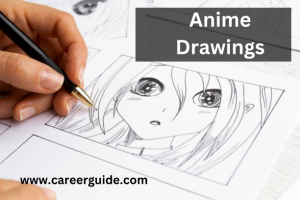
Anime refers to a style of animation that originated in Japan and has turn out to be a international phenomenon. Characterized by using its colorful paintings, fantastical issues, and colourful characters, anime includes a huge range of genres, from motion and adventure to romance and technological know-how fiction. It transcends age barriers and has a unique potential to captivate audiences of all demographics.
The appeal of anime drawings lies in their capacity to carry feelings, tell compelling memories, and delivery visitors to imaginitive worlds. The wonderful visible fashion, with its exaggerated capabilities and expressive characters, affords artists with a charming canvas to explore their creativity. Through anime drawings, artists can speak a big selection of feelings and narratives, making it a powerful and versatile shape of inventive expression.
Getting Started with Anime Drawings
2.1 Essential Tools and Materials
- Before diving into your first anime drawing, it is essential to accumulate the proper gear and materials. Unlike different sorts of art, anime drawing would not always require an in depth array of substances. At its center, you may want:
- Pencils: A set of exquisite pencils for sketching and outlining.
- Erasers: Both a smooth eraser for fashionable use and a precision eraser for finer information.
- Paper: Choose clean, high-quality paper suitable for your preferred medium (pencil, ink, or virtual).
- Pens/Inking Tools: If you intend to ink your drawings, invest in best-line pens or different inking tools.
- Coloring Materials: Depending on your desire, this will encompass coloured pencils, markers, or digital gear.
2.2 Setting Up Your Workspace
- Creating a conducive workspace is vital for a efficient and enjoyable drawing experience. Ensure properly lighting fixtures to avoid straining your eyes and installation a comfortable chair and desk. Organize your equipment within easy reach, retaining your workspace muddle-unfastened to permit for seamless creativity.
2.3 Basic Anatomy and Proportions in Anime
- Understanding fundamental anatomy is the cornerstone of making sensible and visually appealing anime characters. While anime often involves exaggerated functions, having a draw close of human anatomy provides a strong foundation for stylization. Pay interest to proportions, mainly whilst drawing faces, eyes, and our bodies. Learning the underlying shape will empower you to break free and experiment with distinct styles confidently.
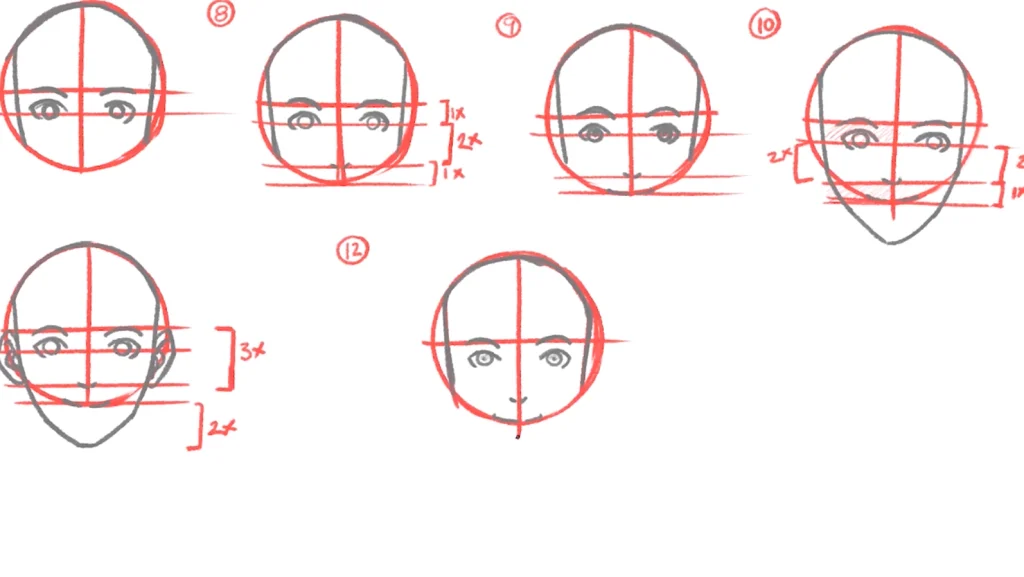
Understanding Anime Facial Expressions Anime Drawings
In this segment, we will delve into the intricacies of shooting feelings on your anime drawings.
3.1 Breaking Down Facial Features
- Before you can master facial expressions, it is crucial to break down the character capabilities that contribute to them. Pay close interest to the eyes, eyebrows, mouth, and nostril, as every element performs a pivotal function in conveying feelings. Experiment with different shapes, sizes, and angles to understand how these features have interaction to create various expressions.
- Eyes: Anime eyes are particularly expressive. Experiment with special sizes, shapes, and styles to convey various feelings. Large, glowing eyes regularly denote innocence or excitement, at the same time as slim or squinted eyes can suggest skepticism or intensity.
- Eyebrows: The position and perspective of eyebrows contribute extensively to facial expressions. Raised eyebrows can bring surprise or interest, at the same time as reduced eyebrows can also suggest anger or dedication.
- Mouth: Anime mouths come in various paperwork, from small and diffused to huge and exaggerated. Practice drawing exclusive mouth shapes to painting happiness, unhappiness, or different emotions.
3.2 Expressions and Emotions in Anime
- Understanding the correlation between facial expressions and feelings is pivotal in anime drawing. Here are a few not unusual expressions and the feelings they generally bring:
- Smile: Happiness, joy, friendliness.
- Frown: Sadness, unhappiness, situation.
- Raised Eyebrows: Surprise, curiosity, exhilaration.
- Narrowed Eyes: Determination, suspicion, intensity.
- Tears: Sadness, frustration, empathy.
- Blushing: Embarrassment, shyness, love.
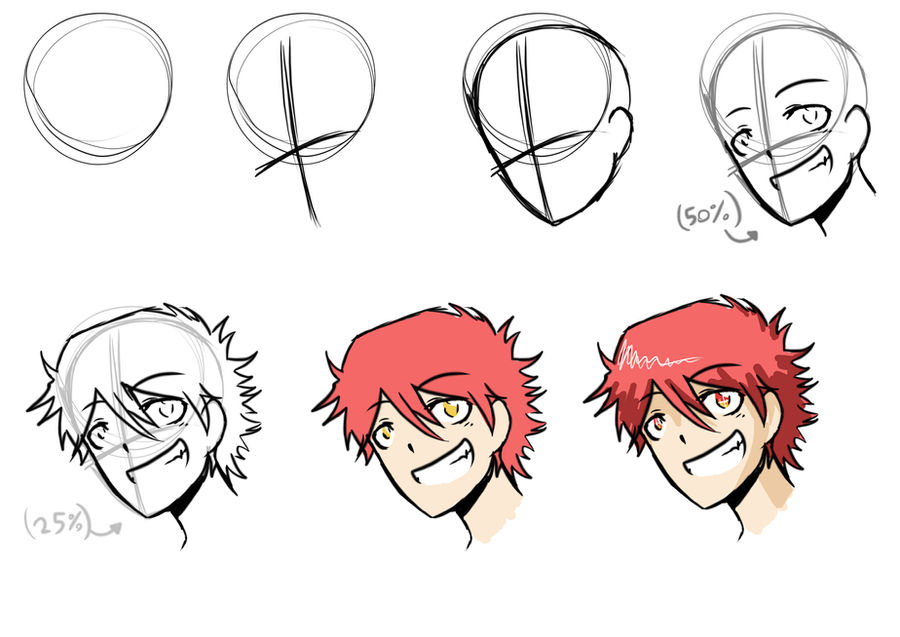
3.3 Tips for Capturing Expressions Effectively
- Study Real Faces: Observing real faces and their expressions is an splendid manner to grasp the subtleties of emotion. Pay attention to how muscle tissue move and features exchange throughout exceptional emotional states.
- Practice Expressions Regularly: Dedicate time to exercise drawing numerous facial expressions. This may be executed through short sketches or focusing on unique feelings in every consultation.
- Experiment with Styles: Anime offers a huge spectrum of styles. Experiment with one-of-a-kind anime styles to find one that resonates along with your artistic vision at the same time as efficiently conveying feelings.
- Mastering anime facial expressions is an ongoing journey. As you still discover and refine your capabilities, you may discover your precise method to capturing the feelings that breathe life into your characters.
Mastering Anime drawings Hair
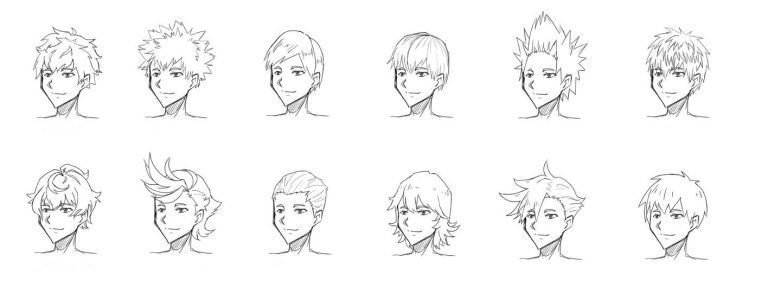
Anime drawings hairstyles are diverse and can be a defining function of a person. In this segment, we are able to explore the intricacies of drawing anime hair, from specific patterns to step-by-step strategies that will help you carry a number of dynamic and visually appealing hairstyles to life.
4.1 Different Anime Hairstyles
- Anime characters are recognised for his or her particular and innovative hairstyles. Before diving into drawing, get yourself up to speed with a few not unusual anime
hairstyles: - Spiky Hair: Often associated with active and adventurous characters.
- Bob Cut: A classic and flexible fashion suitable for numerous personalities.
- Long Flowing Hair: Symbolizes beauty, thriller, or a free-lively nature.
- Twin Tails: Playful and regularly related to lovable or mischievous characters.
- Messy Hair: Conveys a carefree or rebellious attitude.
4.2 Step-with the aid of-Step Hair Drawing Techniques
1- Step: Outline the Hair Shape
- Start by outlining the overall form of the hair. Consider the duration, extent, and average fashion of the coiffure you want to portray.
2- Step: Add Sections and Strands
- Break down the hair into sections and strands. Anime hair is regularly stylized with wonderful, formidable strands. Experiment with one of a kind patterns to create visual interest.
3- Step: Define the Hairline
- Outline the hairline, being attentive to the way it frames the face. Anime hairlines can range from easy to complex, relying at the man or woman’s age and character.
4- Step : Add Volume and Texture
- Use shading and features to feature quantity and texture to the hair. Consider the path of mild to decide in which shadows and highlights fall.
5- Step: Refine Details
- Refine the info by using including smaller strands, wisps, or add-ons if relevant. This step permits you to feature character and uniqueness to the individual’s coiffure.
4.3 Adding Depth and Texture to Anime Hair
- Shading: Pay interest to light sources and shadows when shading the hair. This adds depth and realism for your drawings.
- Texture: Experiment with extraordinary textures to beautify the general look of the hair. Whether it is silky and smooth or tough and messed up, texture adds individual to anime hair.
- Accessories: Don’t neglect to bear in mind add-ons like hairpins, ribbons, or hats. These information can complement the hairstyle and contribute to the character’s story.
Creating Dynamic Anime Drawings Eyes
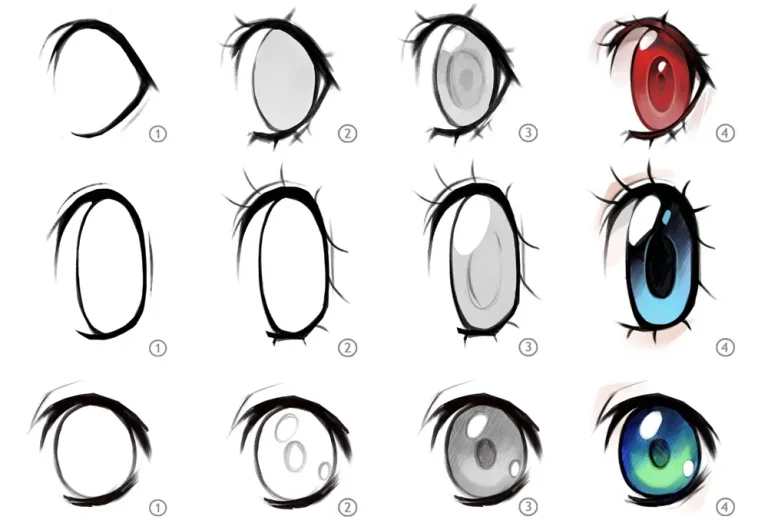
Anime eyes are iconic and play a critical function in expressing feelings and personal. In this section, we’ll delve into the artwork of drawing anime eyes, exploring diverse patterns, expressions, and step-via-step strategies to infuse existence into your characters.
5.1 Importance of Eyes in Anime
- Anime eyes are often the focus of a person’s layout, maintaining the important thing to expressing emotions and conveying the character’s essence. The size, form, and detailing of anime eyes can range broadly, contributing to the uniqueness of each character.
5.2 Variations of Anime Eyes
- Big, Expressive Eyes: Commonly associated with innocence, teens, and emotional expressiveness.
- Narrow Eyes: Conveying depth, dedication, or a extra mature demeanor.
- Eye Shapes: Anime eyes could have diverse shapes, from round to almond-fashioned or maybe elongated triangles, every contributing to a man or woman’s persona.
5 .3 Step-with the aid of-Step Guide to Drawing Anime Eyes
1- Step: Outline the Eye Shape
- Begin by means of outlining the simple shape of the eyes. Consider the style and persona of your individual whilst selecting the attention shape.
2- Step: Add the Pupil and Iris
- Draw the student and iris within the outlined form. Experiment with student length and location to carry unique emotions.
3- Step: Define the Eyelashes
- Add eyelashes to decorate the expressiveness of the eyes. Vary the duration and thickness based on the man or woman’s gender and fashion.
4- Step: Add Eyebrows
- Draw eyebrows that complement the expression of the eyes. Raised eyebrows can advocate marvel, even as reduced eyebrows may additionally bring dedication or depth.
5- Step: Shade and Add Highlights
- Use shading to add depth to the eyes. Consider the course of mild to decide where shadows fall. Add highlights to create a reflective, lively impact.
5.4 Tips for Capturing Expressive Eyes
- Experiment with Styles: Anime gives a huge variety of eye patterns. Experiment with one of a kind shapes, sizes, and detailing to discover a fashion that suits your inventive vision.
- Study Emotions: Observe how real eyes express emotions and contain the ones subtleties into your drawings. Pay interest to the site of the eyes and eyebrows at some point of extraordinary emotional states.
- Practice Consistently: Drawing expressive eyes is a talent that improves with exercise. Dedicate time to often sketching and refining your eye-drawing techniques.
Posing and Gesture Anime Drawings

Posing and gesture drawing are critical elements in growing dynamic and engaging anime characters. In this segment, we are able to delve into the importance of dynamic poses, techniques for conveying feelings via frame language, and guidelines for achieving fluidity in your anime drawings.
6.1 Importance of Posing in Anime
- The electricity of a nicely-completed pose can’t be overstated in anime drawings. Posing no longer only displays the person’s persona however also conveys emotions, units the tone for a scene, and contributes to the overall narrative. Whether it is a heroic stance, a moment of vulnerability, or an movement-packed pose, the manner a character includes themselves speaks volumes.
6.2 Gesture Drawing Techniques
1- Step: Capture the Essence
- Begin with short, loose sketches to seize the essence of the pose. Focus on the overall flow and strength instead of getting bogged down by means of info at this stage.
2- Step : Define Body Language
- Build upon the initial gesture by defining the individual’s body language. Consider their emotions, intentions, and the narrative context. A individual’s posture, gestures, and stance ought to align with the tale you are telling.
3- Step: Experiment with Perspective
- Play with distinctive views to feature depth and interest on your poses. Experiment with foreshortening and varying angles to create a experience of drama or motion. This provides visual effect for your drawings.
4- Step: Emphasize Contrasts
- Introduce contrasts for your poses to lead them to visually compelling. Experiment with angles, shapes, and proportions to create a dynamic composition. Contrasts upload interest and emphasize the uniqueness of your individual.
6.3 Bringing Life to Your Characters thru Poses
- Observe Real Life: Study people in distinct conditions to apprehend how frame language conveys emotions. This remark will decorate your capacity to create real and relatable poses.
- Use Reference Images: Collect reference photographs or take snap shots of yourself or others in numerous poses. These references can serve as treasured gear for understanding anatomy and reaching sensible poses.
- Tell a Story: Consider the narrative context of your drawing. The pose need to align with the person’s story, supplying insight into their journey, struggles, or triumphs.
Coloring Techniques for Anime Drawings
Adding color for your anime drawings is a vibrant and expressive way to deliver your characters to life. In this segment, we’re going to explore the importance of selecting the right color palette, one-of-a-kind coloring strategies for each conventional and virtual mediums, and recommendations for reaching vibrant and realistic shades on your anime art work.
7.1 Choosing the Right Color Palette
- Consider the Character’s Personality: The colors you pick need to reflect the character and developments of your man or woman. Bright and heat colorations can also deliver friendliness and power, while cooler tones can evoke a experience of calm or thriller.
- Think about the Setting: Consider the environment in which your man or woman exists. The coloration palette may be stimulated with the aid of the mood and surroundings of the scene. Natural environments might use earthy tones, whilst fantastical settings allow for extra innovative and numerous color picks.
- Experiment with Complementary Colors: Complementary colorations, the ones opposite every different at the colour wheel, can create visible hobby and concord. Experiment with combos like blue and orange or pink and inexperienced to make certain factors pop.
7.2 Traditional vs. Digital Coloring
Traditional Coloring:
- Use notable coloured pencils, markers, or watercolors for traditional anime coloring.
- Layering is fundamental to attaining depth. Start with light layers and progressively building up depth.
- Pay attention to mixing strategies to create smooth transitions between colorings.
Digital Coloring:
- Digital gear like photograph pills and software program offer flexibility and precision.
- Experiment with layering and blending modes to reap various effects.
- Utilize virtual brushes to create textures and info no longer without difficulty practicable with conventional tools.
7.3 Tips for Achieving Vibrant and Realistic Colors
- Understand Color Theory: Familiarize yourself with coloration concept principles, along with complementary colorations, analogous shades, and coloration concord. This know-how will guide your shade alternatives and create visually attractive compositions.
- Pay Attention to Lighting: Consider the route and depth of light sources for your paintings. Shadows and highlights contribute to the three-dimensional feel of your drawings.
- Use Multiple Shades: Adding multiple shades of a colour provides depth and realism. Don’t restriction yourself to flat colours; introduce shading and highlights to enhance the dimensionality of your characters.
- Experiment with Textures: Consider including texture to clothing, hair, or backgrounds. This may be finished thru numerous techniques, whether or not the usage of textured brushes digitally or experimenting with conventional techniques like cross-hatching.
Backgrounds and Environments in Anime Drawings
While characters take center stage in anime drawings, backgrounds and environments play a crucial position in setting the scene and enriching the narrative. In this phase, we will explore the importance of well-crafted backgrounds, different methods to growing them, and recommendations for bringing lifestyles to the worlds your characters inhabit.
8.1 Setting the Scene: Importance of Backgrounds
- Backgrounds offer context, temper, and a experience of region for your anime drawings. A well-designed heritage can enhance the storytelling element of your art work, transporting visitors to different settings and scenarios. Whether it is a bustling city, a serene landscape, or a paranormal realm, backgrounds make contributions to the overall visual impact of your composition.
8.2 Simple Background Techniques
- Layering: Create depth by way of layering elements for your heritage. Foreground elements ought to be more special and colourful, whilst remote items may be softer and much less defined. This mimics the way our eyes understand depth in the real global.
- Perspective: Pay interest to angle to give your backgrounds a experience of scale and distance. Use converging traces to guide the viewer’s eye and create a more immersive revel in.
- Color Gradients: Experiment with colour gradients to bring one-of-a-kind times of day or atmospheric situations. Warm shades can advocate a sundown, while cool tones evoke a moonlit night time.
8.3 Creating Atmospheric Environments
- Weather and Lighting: Consider the effect of climate and lighting fixtures to your surroundings. Rain, daylight, or mist can upload ecosystem and mood to your scenes. Adjust the colors and lights to in shape the situations you want to convey.
- Details and Consistency: Incorporate constant details at some stage in your heritage to maintain a cohesive appearance. Pay interest to architectural factors, foliage, or terrain features that match the general subject matter of your drawing.
- Story Integration: Think about how the historical past supports the tale or character narrative. The putting should supplement and decorate the emotions or moves of your characters.
8.4 Tips for Background Drawing
- Practice Perspective Drawing: A stable information of angle is essential for creating realistic backgrounds. Practice drawing one-of-a-kind scenes and test with vanishing factors and horizon traces.
- Reference Images: Use reference pics for inspiration and to recognize how real-global environments are based. This let you create greater actual and visually compelling backgrounds.
- Experiment with Styles: Backgrounds in anime can variety from noticeably designated and realistic to simple and stylized. Experiment with distinct styles to locate what fits your artistic vision and complements your characters.
Advanced Tips and Tricks Anime Drawings
As you progress in your anime drawing adventure, it is time to explore advanced techniques which could elevate the fine and effect of your artwork. In this segment, we will delve into nuanced elements inclusive of incorporating shadows and highlights, using reference pix correctly, and experimenting with specific patterns to refine your artistic expression.
9.1 Incorporating Shadows and Highlights
- Understand Light Sources: Identify the primary light source on your composition. Shadows should fall contrary to the direction of mild, and highlights ought to be wherein the mild without delay hits the surfaces. This know-how provides intensity and realism to your drawings.
- Experiment with Light Intensity: Vary the intensity of light to create mood and surroundings. Soft lighting fixtures may additionally convey a gentle or romantic scene, even as harsh lights can evoke tension or drama.
- Use Gradients: Smooth gradients can be implemented to shadows and highlights to obtain a extra natural transition between light and dark areas. This approach is specially effective in digital art.
9.2 Using Reference Images Effectively
- Expand Your Visual Library: Collect a numerous range of reference images to increase your visual library. Reference snap shots help you understand the information of anatomy, clothing, poses, and environments, contributing to the authenticity of your drawings.
- Study Artwork with the aid of Masters: Analyze art work by using finished anime artists and examine their strategies. Break down their use of coloration, shading, and composition to advantage insights into advanced creative ideas.
- Blend and Adapt References: Instead of copying reference pix immediately, combo and adapt elements to create some thing particular. This lets in you to increase your fashion while incorporating the knowledge gained from references.
9.3 Experimenting with Different Styles
- Explore Genre-specific Styles: Anime spans numerous genres, every with its specific artwork style. Experiment with one of a kind patterns to healthy the temper and subject of your drawings. Styles can variety from the certain and practical to the simplified and expressive.
- Combine Eastern and Western Influences: Blend elements from both Eastern and Western artwork styles to create a fusion that provides a unique aptitude for your drawings. This synthesis permits for a broader variety of creative expression.
- Develop Your Signature Style: While experimentation is important, awareness on refining and evolving your very own signature fashion. A specific style sets your artwork apart and makes it right away recognizable.
9.4 Pushing the Boundaries of Expression
- Add Symbolism: Incorporate symbolic elements into your drawings to deliver deeper meanings or subject matters. Symbolism adds layers of storytelling that cross beyond the visual aesthetics.
- Experiment with Unconventional Proportions: Challenge traditional proportions to create characters with precise and noteworthy functions. This method lets in for a greater fantastical and imaginative visual impact.
Frequently Asked Questions (FAQs)
A1: Begin with the aid of amassing important equipment together with pencils, erasers, and paper. Practice basic anatomy and proportions, and regularly discover facial capabilities, hairstyles, and poses.
A2: Anime facial expressions involve expressive eyes, varied eyebrows, and mouth shapes. Understanding how those elements deliver feelings is crucial for capturing the essence of characters.
A3: Experiment with specific anime hairstyles, use step-by means of-step strategies, and cognizance on including volume and texture. Consider the character’s character while deciding on a hairstyle.




















